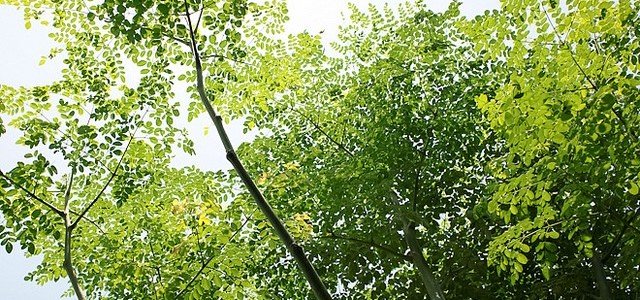Moringa: the ‘Miracle Tree’
It’s been called “the Miracle Tree,” “the Tree of Life” and “Mother’s Milk.” It is one of the most nutrient-dense plants on the planet, it is becoming increasingly important part of plans to combat malnutrition in the global South – while in the West it is fast gaining popularity as the new “superfood.”
So what is that’s so special about the moringa tree?
Moringa olifera, also known as the drumstick tree or horseradish tree, is a fast-growing, drought-resistant tree native to the southern foothills of the Himalayas in northwestern India. It can reach a height of 10–12m, it has fragile branches, delicate, feathery leaves and long, three-sided seed pods which hang down in clusters.
Moringa was used in perfume manufacture in ancient Egypt, classical Greece, and the Roman Empire. It has been prized for centuries for its nutritional and healing properties in Asia and Africa, where the young leaves, stalks and pods are eaten as a vegetable.
When grown from cuttings, the first harvest can be taken within six months of planting. Fruits often do not appear in the first year and for the first few years yields are generally low. By year two, a single tree can produce around 300 pods, by year 3 around 400-500. A good tree can yield 1000 or more pods.
The leaves and stems can be harvested from the young plants 60 days after seeding and then another seven times in the year. Typical yields are six tonnes of fresh matter per hectare per year. Harvests vary sharply between the rainy and dry seasons, with around 1120 kg/ha per harvest and 690 kg/ha per harvest respectively.
Once cut, the leaves should not be exposed to direct sunlight so in some regions they are traditionally harvested in moonlight. The leaves are then washed in purified water and naturally shade-dried.
Moringa seed pods
Moringa flowers are used to make tea, and mature seeds can be roasted and eaten like peanuts. Moringa seed powder has anti-bacterial properties (and is also highly effective as a water purifier).
The immature seed pods, or “drumsticks”, are a favourite dish in South Asia, where they are parboiled and cooked in a curries. In the Philippines, moringa leaves are traditionally added to broth used to make a simple soup.
When analysed and broken down, the wealth of natural minerals and compounds contained within the plant read like a catalogue of some of the most important essential nutrients for human health and well-being.
The leaves and seeds are packed with 27 vitamins, 9 essential amino acids, 46 anti-oxidants, numerous minerals and high concentrations of protein
According to a US manufacturer of moringa health food supplements, gram for gram moringa leaves contain: Twice the protein of yoghurt; four times the vitamin A of carrots; three times the potassium of bananas; four times the calcium of milk and seven times the vitamin C of oranges.
Studies have shown the micro-nutrient content is even greater when the leaves are dried: Ten times the vitamin A of carrots; 17 times the calcium of milk; 15 times the potassium of bananas; 25 times the iron of spinach and nine times the protein of yogur.
Increasingly moringa trees have been advocated to combat malnutrition, especially among infants and nursing mothers. Development NGOs including The Christian and Missionary Alliance, Church World Service, Educational Concerns for Hunger Organization, and Volunteer Partnerships for West Africa have advocated moringa as “natural nutrition for the tropics”.
Since moringa thrives in arid and semiarid environments, it can be particularly useful as a food source during dry seasons. One commentator states, “the nutritional properties of moringa are now so well known that there seems to be little doubt of the substantial health benefit to be realized by consumption of moringa leaf powder in situations where starvation is imminent.”
In recognition of the plant’s value, the UN Food and Agriculture Organisation named moringa as Traditional Crop of the Month in September 2014.
As well as being a great source of nutrition, moringa also has proven health benefits and has been shown to boost immunity in HIV patients. It is reputed to lower blood pressure, alleviate stress, fight fatigue, improve digestive health – and is said to be a tonic for the hair, nails and skin.
In traditional Ayurvedic medicine it is reported to cure as many as 300 diseases. There is strong evidence that moringa flower juice can improve human lactation and a tea made of its leaves can fight colds and infections. The fresh leaves are said to cure anemia, gastric ulcers and diarrhea, and a paste made of the leaves provides anti-bacterial and anti-inflammatory treatment for insect bites, wounds or fungal skin problems. Crushed seeds are used to aid cramps, rheumatism and arthritis and as a natural antibiotic.
Since landing in London’s top department stores, Selfridges and Liberty’s, and on the shelves in Holland & Barrett stores nationwide Moringa leaf powder has become one of the fastest-selling superfoods in the UK.
Donate today
Support communities to plant nutrient rich and drought-resistant trees like Moringa.



